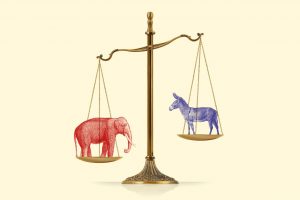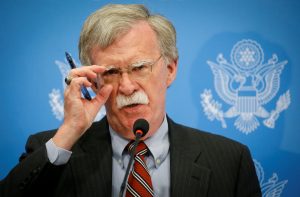As the 2024 U.S. presidential election approaches, the contest between Vice President Kamala Harris and former President Donald Trump is becoming increasingly competitive, especially in critical swing states.

Harris Mylonas is Associate Professor of Political Science and International Affairs at George Washington University.
Arriving in the United States just days before the 9/11 terrorist attacks, Harris Mylonas’s academic journey has taken him through the University of Chicago, Yale, and Harvard before settling in Washington, D.C., 15 years ago. In that time, he has engaged with political strategists, campaign managers, diplomats, and public officials, gaining invaluable insights about the U.S. political system. Remarkably, he cast his first vote in a U.S. election only during the 2022 midterms. This trajectory provides him with a distinctive outsider-insider viewpoint.
In reflecting on the increasingly polarized political climate, Mylonas notes a significant shift: while U.S. elections in the early 2000s appeared less divided compared to Greece’s tumultuous political environment, today’s American landscape is markedly more contentious.
In this interview, Mylonas delves into the key battleground states, the issues that could influence undecided voters, and the unpredictable nature of opinion polling. As Harris and Trump vie for the presidency, he offers insights into the critical factors that could ultimately determine the outcome of this high-stakes election.
Where does the race for the presidency stand today?
The race for the U.S. presidency is extremely tight. Kamala Harris and Donald Trump are nearly deadlocked in key swing states. As your readers may know, in over 40 out of the 50 states in the U.S. we can safely predict which party will win on November 5. Each side begins from about 220 electoral votes. However, the path to the 270 of the 538 Electoral College votes needed to win the presidency goes through the few states that are too close to call. For example, Michigan, Pennsylvania, Wisconsin, Georgia, North Carolina, Arizona, and Nevada. Thus, while national polling shows Harris slightly leading Trump, the race remains within the margin of error, and more importantly the path to the White House depends on which swing states will go to either side. The latest polls show a razor-thin race between Harris and Trump. In crucial states like Michigan, Pennsylvania, and Wisconsin, Harris holds a narrow lead, but Trump’s strengths in handling economic and immigration issues make these states highly competitive.
What are the key issues driving voter decisions? Is the phrase “It’s the economy, stupid” still relevant today?
Key issues in the voters’ minds include inflation and immigration, areas where Trump appears to hold an advantage. Trump is perceived as stronger on the economy and border security, while Harris has the edge on healthcare. Swing state voters are very concerned about the economy—inflation in particular, and many are looking to see who can address these pressing issues effectively before deciding how to vote.
Can you outline the potential paths to victory for each candidate?
Sure. Let’s start with Vice President Kamala Harris. If she secures victories in the so called “Blue Wall states” of Michigan (15 electors), Pennsylvania (19 electors), and Wisconsin (10 electors), which Biden narrowly won in 2020, and either Arizona (11 electors) or Georgia (16 electors) she will reach 270 and seal her path to the presidency. This of course assumes that she keeps Nevada (6 electors).
Turning to former President Donald Trump, he needs to flip key swing states that he lost in 2020 to win. One pathway to the White House involves winning Arizona (11 electoral votes) and Georgia (16 electors), both of which he narrowly lost last time, and reclaim the “Blue Wall states” of Michigan (15 electors), Pennsylvania (19 electors), and Wisconsin (10 electors). This assumes that Trump will also hold onto traditional Republican strongholds like Florida (30 electors) and North Carolina (16 electors).
Do you anticipate any surprises that could shift the race?
I just mentioned North Carolina as a traditional Republican stronghold. However, recent developments with the Republican candidate for Governor may upset the result. If this scenario pans out, Harris’ path to the White House may become more likely because it can offset losses in other states.
Why have opinion polls struggled to accurately predict election outcomes, and why do we keep getting so many competing estimates in several swing states?
Opinion polls have at times struggled to give us an accurate picture in recent elections. One issue is “nonresponse bias” which refers to the situation where pollsters cannot reach certain groups such as rural or low-income voters. Another reason may be “shy voters,” a term describing those hesitant to express their true preference for controversial candidates. In Greece, we experienced this issue when opinion polls were not capturing Golden Dawn’s actual electoral strength. These two factors can skew polling results.
Moreover, there are always “late deciders” that choose what to vote for on the day of the election, and this makes it hard for the pollsters to capture the actual outcome, especially in such close races. Add to the above, the fact that Robert F. Kennedy Jr. recently withdrew from the race announcing that he will support Trump’s bid for the White House, and quickly on top of the existing pool of undecided voters you have an extra pool of Kennedy Jr. voters.
All of these add “noise” to our ability to predict. Turning to the conflicting estimates within key swing states, they partly arise because different pollsters use various methodologies. Each one may use a different sample size, weighting, or even question phrasing. These choices can also lead to varied estimates.
In your view, what will ultimately decide the outcome of this election?
The ultimate factor, not often talked about, has to do with turnout on the day of the election. I strongly believe that this will be a decisive factor for who wins on November 5th.







